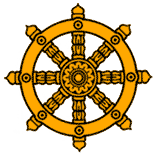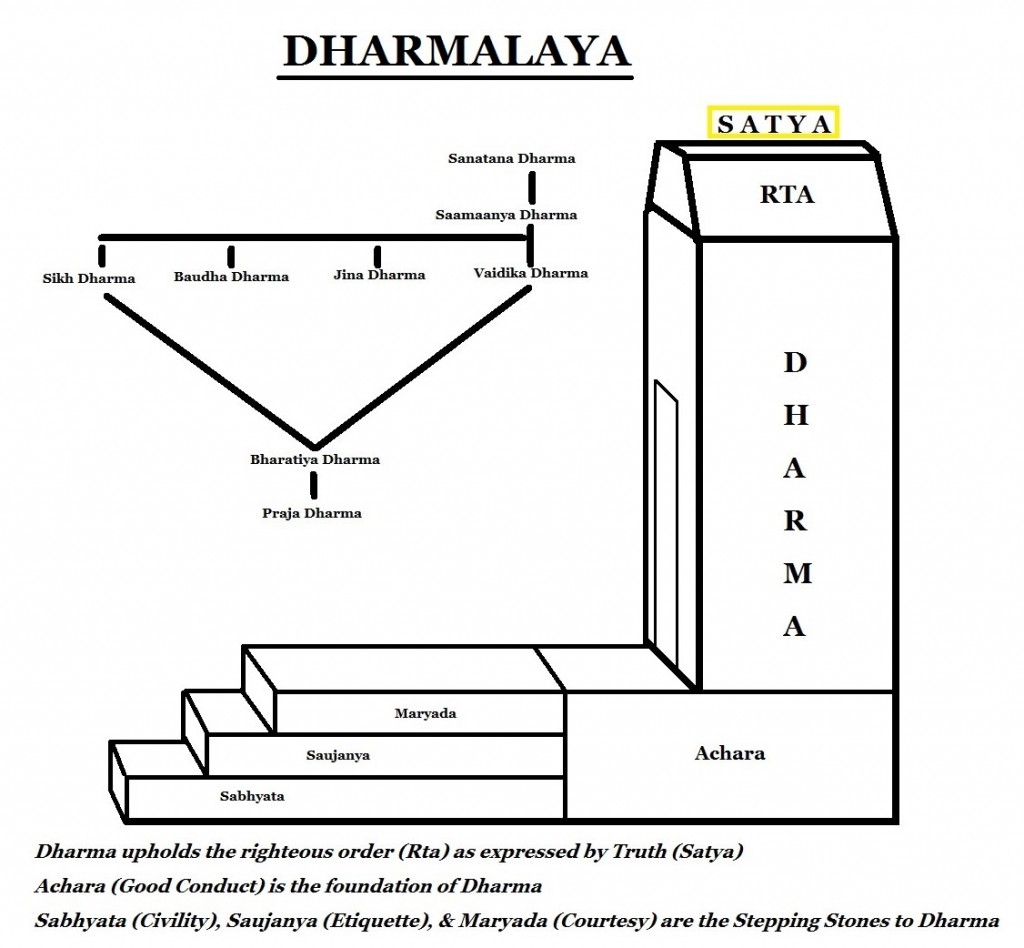This Indic Civilizational Portal Post updated an ACP article published on August 7, 2013

To understand Dharma is to understand Indic civilization and its myriad cultures.
It is Dharma that is the organizing principle of Bharatavarsha and indeed, the most powerful idea in the literary heritage of the Indian Subcontinent in general, and India in particular.
The four native religions of Bharat (Hindu, Jain, Buddhist, and Sikh) all emphasize the centrality of Dharma as the core ideal of our Sanskriti and Bharatiyata. Therefore, to understand and appreciate the culture of Indic Civilization, one must be conversant in the ways of Dharma. This Post will highlight the subtlety, context sensitivity, and profoundness of Dharma.
On Dharma
The essence of Dharma is not based on an obsession with caste or ritual. Rather, it is about righteousness and duty and sacrificing one’s self for others. To understand dharma is to understand the cosmic order of the universe, Rta, which is rooted in truth, Satya. Dharma’s root word in Sanskrit is dharyate (literally, to uphold the order). Thus, practitioners of dharma must uphold this order.
The core of this order is not focused on the trivialities of caste and the divinely intended accident of birth, but rather, of mother raising child, husband protecting wife, child taking care of old parents, and rich assisting poor. It is about strong defending weak and putting societal interest before self interest–that is the heart of Dharma.
This essence is expounded not only in Sanatana Dharma, Hinduism, but also in the great texts and philosophies of Jainism, Buddhism, and Sikhism, all of which venerate Bharatavarsha as their punyabhoomi, or home of their holy sites (both North and South of the Vindhyas). Whether it is the Eightfold path or Ashtanga Yoga, the same concepts of right conduct and yama-niyama form the foundation of all these paths, and therefore, transcend all panths (religions). Whether it is the Five Main Vows or the Five K’s (kesh, kanga, kirpan, kara, kachera), the guidelines (and the symbolic ideals that they embody) have a similarity that is identifiable to even the unschooled. The common values, courtesies, and guiding principles are immanent in the Purvas and Guru Granth Sahib alike. The same distinguishment between illusion and reality and encouragement of self-study and spiritual knowledge can be found in the Dharmasastra as well as the Dhammapada. Even the same reverence for life through common practices and encouragement of vegetarianism is apparent. This is because Dharma (righteousness), and especially Bharatiya Dharma, transcends religion (panth).
Vaidika Dharma (sanatana dharma as expressed by the Vedas) has three parts, karma kanda (which requires ritual and yagna), jnana kanda (knowledge of the truth as contained in the Upanishads), and upasana/bhakti kanda (which emphasizes compassion for all and devotion to God as seen in the Bhagavata Purana).
Karma kanda is the spiritual kindergarten (Swami Vivekananda himself spoke of this). It disciplines the individual so that he is fit to receive knowledge of reality (jnana). This knowledge and awareness of God, or Brahman, in all things, is what leads to worship/devotion and compassion (upasana/bhakti and karuna) It is for this reason that Vedanta, literally the End of the Vedas, is the object, rather than mere yagna and ritual.
Those who misunderstand or even misinterpret dharma get lost in the trivialities of karma kanda. They grow arrogant of their religious merit and birth and forget the true purpose of the exercise. If we are all mere creations of God, where is the place for arrogance and contempt towards our fellow man or even living thing of whatever background? After all, could not the brahmin have been a dalit in a previous life? Could not the dalit have been a brahmin in a previous life?
Arrogance of birth, lineage, caste, knowledge, and religious merit are some of the most dangerous as they lead away from the path of sanatana dharma to false ego, pride, anger, and destruction. Mere puja and archana doesn’t take us to God; they are but a start and also an aid to the troubled and anxious. Dharma is the path, and it is acted in the outside world. How we conduct ourselves in all settings (not just in the puja room) and how we treat others is how we are ultimately judged for fitness to reach God (or attain Nirvana).
Vaidika dharma does stipulate Varnashrama Dharma. Literally this emphasizes the division of labour (varna–caste is a misnomer) and stage of life (ashrama) as stipulating the right course of action in a given context. The logic behind this is that no member of society will simultaneously have spiritual, politico-military, commercial, and labor power. Any concentration of power with 2 or more of these types of power leads to tyranny, oppression, and adharma.
While historically traditions naturally passed from father to son (even outside India), in our era, people foolishly believe that birth itself grants privilege. What people forget is that with privilege comes duty.
As such, it is conduct that is the key determinant of a person’s true varna. The dharma or duty that one chooses to follow, whether as teacher/spiritual guide, administrator/warrior, merchant/farmer, or artisan/worker must not be cause for arrogance, but cause for humility. With each varna dharma comes a responsibility to society.
Each individual, no matter how privileged his birth, has a solemn and inalienable duty to society, and should not only behave in harmony with his varna dharma, but must behave in line with the moral commands of Sanatana Dharma, the Eternal Dharma, which is the origin of all dharmas. Each varna is but a mere spoke in the wheel of society, and it is the Chakravartin who turns the wheel in order to uphold Dharma under the auspices of God. Thus those who become arrogant should remember that God has the ability to both grant and take away their position, and they must not abuse their power. Stewardship must be the mindset. Kings do not rule for only their pleasure and glory, and brahmins do not conduct yagnas for their own privilege; both operate as stewards, ruling and teaching respectively, while being ultimately accountable to God.
To move Dharma forward into the modern era, the mistakes of the past must be rectified. This means that the dalit communities of Indian Subcontinent have to be fully integrated. As is the law of the land, so to must untouchability be eliminated at the social level. After all, if the original thinking behind the system was that those who transgressed Dharma would be ostracized from society, how can upper and middle castes continue to bar dalits if they don’t outcaste their own caste brothers who eat beef, etc. today? People cannot ask for privilege while failing to do their duty. What kind of system gives only rights without responsibility? This is certainly not Varnashrama Dharma, let alone Sanatana Dharma.
According to the dharma sutras themselves, outcasted members of society or their descendants can be readmitted after prayascitta (penance/observance) and shuddhi. It is possible to do this by properly and sincerely readmitting the Subcontinent’s dalit jatis back into religious society. This is the best means of not only ensuring social justice to a wronged community, but of ensuring Dharma itself.
Accordingly, there have been many misinterpretations of dharma along the way. One such example is the treatment of the leather worker. While it is one thing to outcaste brahmins, kshatriyas, vaishyas, and sudras who commit personal sin, it is another to unfairly outcaste entire jatis of honest workers performing a service that all of society requires. If leather-working itself is sin, then let all those who wear leather be outcasted as well. People cannot have their cake and eat it too. Leather working is honest work as is sanitation and all members of Indic society must be integrated. Certainly, God himself will not enter, let alone bless the entrants and employees of, a temple that bars his devotees from entering.
Ultimately, what must be remembered by the more ritually inclined of whatever varna is that karmakanda is merely the kindergarten. It is the starting point so that people are fit to receive true knowledge of the existence of God in all things and all living creatures, and most importantly, all human beings. While one can read to know, reading is not understanding. So whatever are the requirements of ritual, be kind and courteous in the performance of those duties, for one will find that jnana and upasana kanda will lead to understanding why humility and compassion for all living things are the gunas that God ultimately wishes to encourage.
Think of others before you think of yourself, that is the surest path to God and at the heart of Dharma.
Stepping Stones to Dharma:
Sabhyata (civility), Saujanya (etiquette), Maryada (propriety), Achara (Good Conduct)
Ideals of Dharma:
Yuktata (Justice), Pavitrata (Purity), Satya (Truth), Karuna (Compassion), Saamyama (Self-control ), Tyaga (Self-sacrifice), and above of all Bhakti/Prema (Divine love)
Pillars of Dharma:
Tapasya (Ascetism), Saucha (Cleanliness), Krupa (Mercy), Satya (Truth)
Definition of Dharma:
Dharma is the protection & upholding of the righteous order Rta as expressed by Satya









